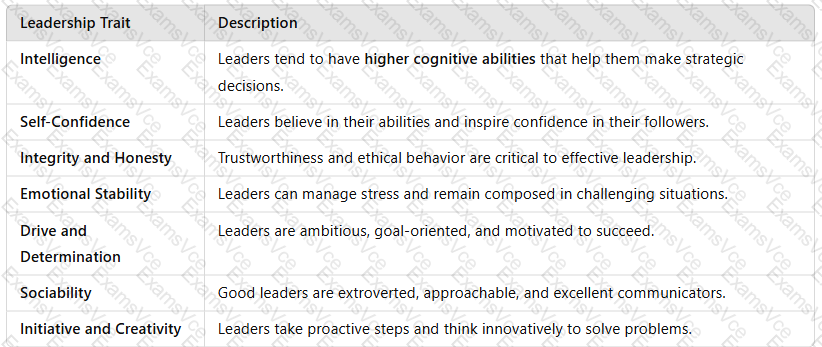CIPS L6M1 Question Answer
Evaluate the 'Traits' approach to leadership (25 points)
The Answer Is:
See the Answer is the explanation.
This question includes an explanation.
Explanation:
Introduction
Leadership plays a pivotal role in organizational success, influencing decision-making, team performance, and strategic direction. One of the earliest and most enduring leadership theories is the"Traits Approach to Leadership."This theory suggests thatcertain inherent traits make an individual an effective leader. Unlike other leadership theories that focus on behaviors or situational factors, the traits approach assumes thatleaders are born, not made.
This essay will critically evaluate thetraits approach to leadership, discussing its key characteristics, advantages, limitations, and relevance in modern organizational contexts, particularly in procurement and supply chain management.
Understanding the Traits Approach to Leadership
Definition
TheTraits Approach to Leadershipis based on the idea that effective leaders possessinherent personality traits that differentiate them from non-leaders.These traits are considered stable over time and consistent across different situations.
Early leadership research focused on identifying thecommon traits found in successful leadersacross industries, military settings, and politics.
Key Characteristics of the Traits Approach
Innate Leadership Qualities– Leadership is seen assomething a person is born with, rather than developed.
Focus on Personality Traits– Effective leaders exhibit specific personality traits such asintelligence, confidence, and emotional stability.
Universal Application– The theory assumes thatleadership traits apply across all industries and organizational settings.
Predictability of Leadership Success– If someone possesses the right traits, they aremore likely to become a successful leader.
Common Leadership Traits Identified in Research
 A screenshot of a computer
AI-generated content may be incorrect.
A screenshot of a computer
AI-generated content may be incorrect.
These traits suggest thatleaders are naturally equipped with qualities that allow them to excel in their roles.
Advantages of the Traits Approach to Leadership (10 Points)
1. Identifies Key Leadership Qualities
Thetraits approach helps organizations identify individuals with leadership potentialby assessing personality traits.
Example: In procurement, a leader withhigh intelligence and problem-solving skillscan effectively negotiate supplier contracts and manage risks.
2. Provides a Foundation for Leadership Selection
Organizations can usepersonality assessmentsto select and promote leaders based on theirinherent characteristics.
Example: A company hiring aChief Procurement Officer (CPO)may look for candidates who exhibitconfidence, strong decision-making skills, and integrity.
3. Universally Recognized and Researched
This approach has beenextensively studied for decades, making it one of the mostwell-documented leadership theories.
Example: Many successful world leaders, such asSteve Jobs and Nelson Mandela, exhibitedself-confidence, resilience, and intelligence—key traits identified in the model.
4. Helps Develop Leadership Training Programs
Although traits are largelyinborn, some leadership traitscan be developed through training and experience.
Example: An employee with high intelligence but low sociability can undergocommunication and emotional intelligence trainingto become a more effective leader.
5. Supports Leadership Continuity and Succession Planning
Organizations canidentify and groom future leadersby assessing leadership traits early in their careers.
Example: A procurement manager withinitiative, strong ethics, and analytical skillscan bepromoted to a strategic leadership role.
Limitations of the Traits Approach to Leadership (10 Points)
1. Ignores the Influence of Situations and Context
Leadership effectivenessdepends on the situationrather than just traits.
Example: A leader withstrong confidence and intelligencemay struggle in ahighly bureaucratic organizationwhere decision-making is slow.
2. Fails to Explain Leadership Development
This theory assumes thatleaders are born, not made, which contradicts modern research showing thatleadership can be learned and developed.
Example: Manysuccessful CEOs started as entry-level employeesanddeveloped their leadership skills over time.
3. Overlooks the Importance of Leadership Behaviors
Having the right traitsdoes not automatically make someone an effective leader—theiractions, decision-making style, and adaptability matter more.
Example: A procurement leader with high intelligence butpoor communication skillsmay fail to build strong supplier relationships.
4. No Clear Agreement on Essential Traits
Different studies identifydifferent sets of leadership traits, making it difficult todefine a universal leadership profile.
Example: Some researchers emphasizecharisma and extroversion, while others focus onhumility and adaptability.
5. Does Not Account for Cultural Differences
Leadership traitsmay not be universal across cultures—a trait that is valuable in one culture may not be as important in another.
Example: InWestern cultures, assertiveness is valued, while inAsian cultures, humility and collective decision-making are preferred leadership traits.
Relevance of the Traits Approach in Modern Organizations
Despite its limitations, thetraits approach remains relevant in leadership selection and development. Modern organizations integrate it withother leadership theoriesto create aholistic leadership model.
1. Integration with Behavioral Leadership Models
Instead of assuming that traits alone determine leadership success, organizations combine it withbehavioral approachesthat emphasize leadership actions.
Example: Transformational leadership combines traits(e.g., charisma, confidence)withinspiring behaviorsto create an effective leadership model.
2. Use in Leadership Assessments and Hiring
Organizations usepsychometric assessmentsto evaluatepotential leadersbased on personality traits.
Example: TheBig Five Personality Model(openness, conscientiousness, extraversion, agreeableness, neuroticism) is commonly used in executive hiring.
3. Helps in Leadership Development Programs
While some leadership traits are inborn, others can bedeveloped through mentorship, training, and experience.
Example: Procurement professionals can enhance theirdecision-making skills, emotional intelligence, and adaptabilitythrough leadership development programs.
Conclusion
Thetraits approach to leadershiphas been afoundational theory in leadership studies, helping organizations understand thequalities that define effective leaders. It provides valuable insights intoleadership selection, succession planning, and training.
However, the approach hasseveral limitations, particularly itslack of situational awareness and failure to explain leadership development. Modern organizations recognize thatwhile leadership traits are important, behaviors, experience, and adaptability play an equally critical role.
The most effective approach to leadershipcombines trait theory with behavioral and situational leadership modelsto create awell-rounded leadership development framework. This ensures that leadership isnot just about natural talent but also about continuous learning, adaptability, and strategic execution.



